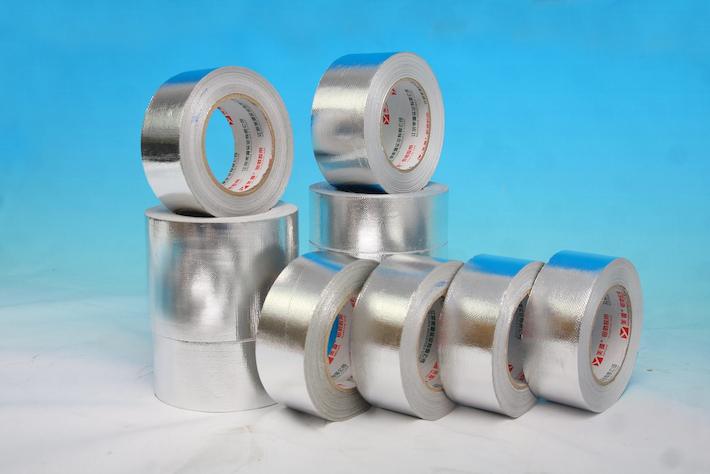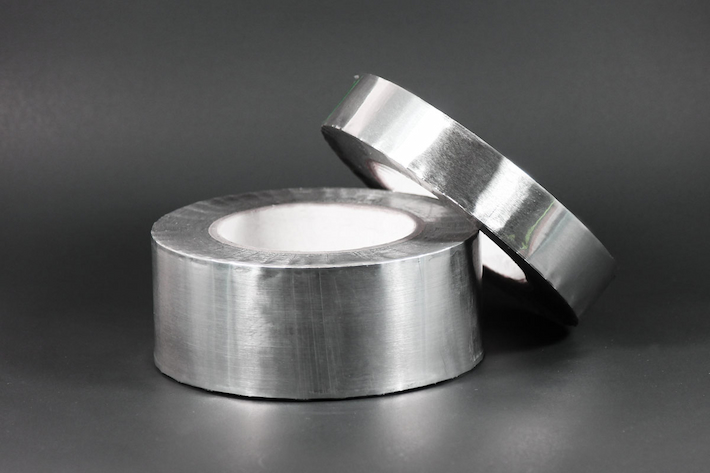By combining the versatility of aluminium and the sealing power and weather-resistant properties of adhesive tape, you get one of the most versatile products used in a wide range of industries – aluminium foil tape with adhesive. Aluminium foil tape is so versatile, that you can see it used in the HVAC, construction, manufacturing and automotive industries. Due to its chemical, moisture and heat-resistant properties, as well as its thermal conductivity, weatherability, and light and heat reflectance, it serves as the go-to tape in a large variety of applications.

History of Aluminium Foil Tape
Aluminium foil tape first became available in 1888, but it wasn’t about two decades later that commercial production started. It quickly became popular due to its protective qualities and attractive looks in packaging and containers. Furthermore, it became the go-to product used in WW II to protect packages, insulate and wrap electrical capacitors. It wasn’t until after the war that it became for commercial use. Aluminium foil tapes feature a specially-engineered metal foil backing that contributes to its malleable, rugged and conductive properties. Foil tape carriers include steel, aluminium, lead, copper, aluminium with glass and copper with tin plating. That being said, when it comes to construction and building, aluminium is the go-to foil tape, which when combined with its long-lasting adhesive is a permanent insulating solution in many applications.
Benefits of Aluminium Foil Tape
Quality aluminium foil tape with adhesive should meet international building code standards and be UL 723 rated. The UL 723 rating refers to the measure of the surface burning properties of building materials. In other words, it refers to the rate of flame spread and the density of smoke that comes as a result of the fire. To meet the international building code standards of fire resistance, composite materials can’t have a flame spread rating higher than 50.

Furthermore, aluminium foil tape generally works in temperatures ranging from 120°C to -30°C and can be applied in temperatures ranging from -10°C to 40°C. Most tapes don’t perform well in colder temperatures, as the cold can harden the adhesive and reduce the sticking power of the tape. So, if you try to apply another type of tape under cold conditions, it may not stick. On the flip side, excessive heat can also melt the adhesive on some tapes, making them useless. Aluminium foil tape is typically all-weather, and it’s coated with a high-quality flame-retardant solvent acrylic adhesive, allowing it to stick in extreme cold and hot weather conditions.
Most duct tapes feature rubber adhesives, which are known to delaminate from their backing in hot applications. While other synthetic rubber adhesives may provide a better range of temperature functionality, it comes at the price of lower mechanical strength, weakness to UV light or weak aging resistance. Foil tapes with acrylic adhesives provide the best of both worlds – superior durability and long stickiness. Moreover, foil tapes are a better alternative to mastic, which can be quite messy to use, and they don’t use as much equipment. They don’t need extra fasteners like drywall mesh, metal screws or scrap metal to seal larger spots, and they can be used to seal holes in air handlers or furnaces.
How to Use Aluminium Foil Tape
In order to insulate or seal ducts, pipes or anything in between, follow these steps:
- Inspect the pipes or ducts for holes and to make sure the seams between the joints and ducts or pipes are tight. Seal any breaches or leaks with aluminium foil tape
- Check with the insulation manufacturer’s instructions on how to properly measure the length of insulation needed to ensure it encircles each duct properly and that it’s neither too loose nor too tight
- For a snug fit, trip away about 5 centimetres of the insulation from the backing to fashion a flap that can overlap the end of the wrapped pipe or duct and provide a smooth surface on which to install the tape
- Wrap the insulation around each pipe or duct, allowing the vapour barrier backing to face out
- Seal every seam with foil tape
- Go along the length of every pipe or duct and ensure every roll of insulation is properly taped to the adjacent strip of insulation
- Besides efficiency, airflow and quality will be improved when the exhaust or HVAC system works as intended
It’s a good idea to inspect flawed pipes or ducts periodically, especially if work has been performed on them recently. One misstep can result in a lot of damage, even if the damage seems insignificant at first. Damaging an exhaust pipe can seriously harm your engine’s air intake and exhaust release, whereas a small hole in your HVAC system can result in great energy losses. Either way, worry not – aluminium foil tape can save the day! Basically, insulating and sealing your pipes and ducts with foil tape can go a long way in ensuring a more efficient system.



